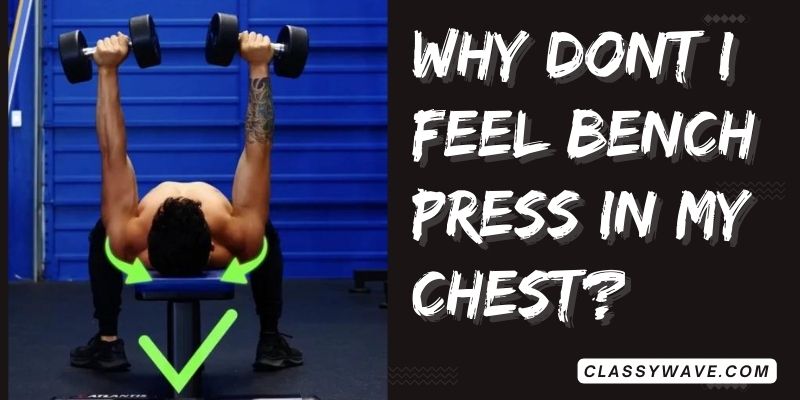why don’t I feel a bench press in my chest? Tips and Tricks
Welcome, young fitness enthusiasts, to the world of weightlifting! If you’re an 8th grader hitting the gym and wondering, “Why don’t I feel bench press in my chest?” you’re not alone. It’s a common concern, and we’re here to help you understand the reasons behind it and how to make the most out of your bench press routine.
Understanding Bench Press
What is Bench Press?
Before we dive into the reasons why you might not be feeling the bench press in your chest, let’s understand what a bench press is. The bench press is a popular strength training exercise that targets various muscle groups, including the chest, shoulders, and triceps. It’s a fundamental movement for building upper body strength.
Reasons You Might Not Feel it in Your Chest
Improper Form
One of the most common reasons you might not feel the bench press in your chest is improper form. Remember, it’s not just about lifting the weight; it’s about how you lift it. Make sure your back is flat on the bench, your feet are firmly planted on the ground, and your grip is correct.
Wrong Grip Width
The width of your grip plays a crucial role in targeting different muscle groups. If your grip is too wide or too narrow, it might shift the focus away from your chest. Experiment with different grip widths and find the one that feels most comfortable while engaging your chest muscles.
Neglecting the Eccentric Phase
The bench press consists of two main phases: the concentric (lifting) and the eccentric (lowering) phase. Some lifters neglect the eccentric phase, dropping the bar too quickly. Controlling the descent of the bar engages your chest muscles more, promoting muscle growth.
Perfect Your Form
Maintaining proper form is crucial for maximizing chest engagement. Ensure your feet are firmly planted, your back is arched, and your shoulder blades are retracted. This not only protects your shoulders but also optimizes the activation of your chest muscles.
Gradual Weight Progression
While challenging yourself is essential, avoid lifting weights that compromise your form. Gradually increase the weight to allow your chest muscles to adapt and grow stronger over time, promoting sustainable progress without sacrificing technique.
Vary Your Grip
Experiment with different grip widths to target various parts of your chest. A wider grip emphasizes the outer chest, while a narrower grip places more emphasis on the inner chest. Rotate between these grips to achieve balanced development.
Pre-Activation Exercises
Include pre-activation exercises before your bench press routine. Movements like cable crossovers or band pull-apart can activate and “wake up” your chest muscles, preparing them for the heavier work to come.
Control the Descent
Don’t let gravity do all the work on the way down. Control the descent of the bar, focusing on the negative phase of the lift. This controlled lowering places additional stress on the chest muscles, contributing to enhanced muscle recruitment.
Utilize Pause Reps
Incorporate pause reps during your bench press. Pausing at the bottom of the movement forces your chest muscles to work harder to initiate the lift, promoting better muscle engagement and control throughout the exercise.
Include Incline Bench Press
Incorporate an incline bench press into your routine. This variation targets the upper chest, providing a well-rounded development and helping to avoid muscular imbalances. Mix incline bench press with flat bench press for comprehensive chest training.
Remember, individual responses to training can vary, so pay attention to how your body responds and adjust your approach accordingly. Consistency and patience are key for long-term progress in building a strong, well-defined chest.
Warm-Up Strategically
Prioritize an effective warm-up to increase blood flow to the chest muscles. Dynamic stretches and light sets of bench presses with lower weights prepare your muscles for the upcoming workload, reducing the risk of injury and enhancing muscle engagement.
Mindful Breathing Techniques
Coordinate your breath with the bench press movements. Inhale deeply as you lower the bar and exhale forcefully as you push it up. Proper breathing not only enhances stability but also promotes better mind-muscle connection, ensuring your chest muscles are actively involved in the lift.
Incorporate Unilateral Movements
Include unilateral exercises like single-arm dumbbell presses. This challenges each side of your chest independently, addressing any muscle imbalances and ensuring both sides contribute equally during bilateral movements like the bench press.
Posture Awareness
Maintain awareness of your overall posture. A strong and stable core supports proper bench press form and chest engagement. Incorporate core-strengthening exercises into your routine to improve overall stability and maximize the effectiveness of your chest workouts.
Track Your Progress
Keep a detailed log of your bench press sessions. Tracking your progress allows you to identify trends, assess the effectiveness of different techniques, and make informed adjustments to your training program for continuous improvement in chest engagement.
Mix in Isometric Holds
Integrate isometric holds at various points in the bench press. Pausing at the bottom, middle, or top of the movement challenges your chest muscles differently, promoting increased muscle activation and endurance.
Optimize Recovery
Adequate recovery is crucial for muscle growth. Ensure you get enough sleep, stay hydrated, and incorporate rest days into your routine. Recovery allows your chest muscles to repair and grow stronger, leading to improved performance during bench press workouts.
Experiment with Tempo Training
Vary the tempo of your bench press reps. Slowing down the eccentric (lowering) phase of the lift increases time under tension, providing a different stimulus for muscle growth and reinforcing chest engagement.
Explore Different Bench Variations
Experiment with different types of benches, such as decline or reverse grip benches. These variations can activate different parts of your chest, offering a well-rounded approach to chest training and preventing monotony in your workouts.
Seek Professional Guidance
Consider working with a fitness trainer or coach, especially if you’re new to bench pressing or looking to refine your technique. Professional guidance ensures that you’re performing exercises correctly and tailoring your routine to your specific needs and goals.
Conclusion
In conclusion, maximizing chest engagement during bench presses involves maintaining proper form, adjusting grip width, emphasizing the eccentric phase, and incorporating various techniques like pause reps and incline bench presses.
Consistent progression, strategic warm-ups, mindful breathing, and recovery optimization contribute to a well-rounded approach. Individual variations exist, so tracking progress and seeking professional guidance can enhance long-term chest development for young fitness enthusiasts.
FAQs
Question: “What’s the correct bench press form to target the chest?”
Answer: Ensure a flat back, proper grip, and controlled descent to engage chest muscles effectively during bench press.
Question: “Can grip width affect chest activation in bench press?”
Answer: Yes, experiment with grip widths; wider grips target the outer chest, while narrower grips emphasize the inner chest.
Question: “How can I enhance chest muscle engagement during bench press?”
Answer: Focus on controlled descent, include pause reps, and incorporate an incline bench press for comprehensive chest development.
Question: “Should I adjust the tempo of my bench press for better chest engagement?”
Answer: Yes, slowing down the eccentric phase increases time under tension, promoting muscle growth and reinforcing chest engagement.
Question: “Are pre-activation exercises beneficial before bench press?”
Answer: Yes, movements like cable crossovers or band pull-apart activate chest muscles, preparing them for heavier bench press work.







